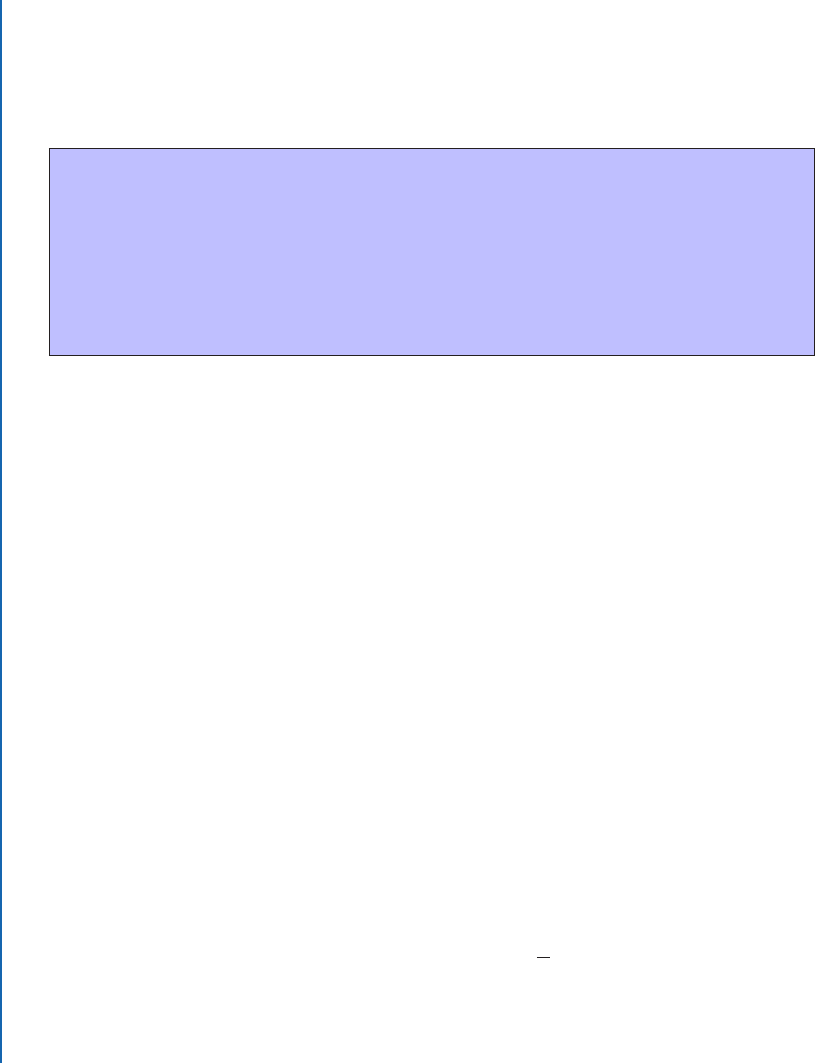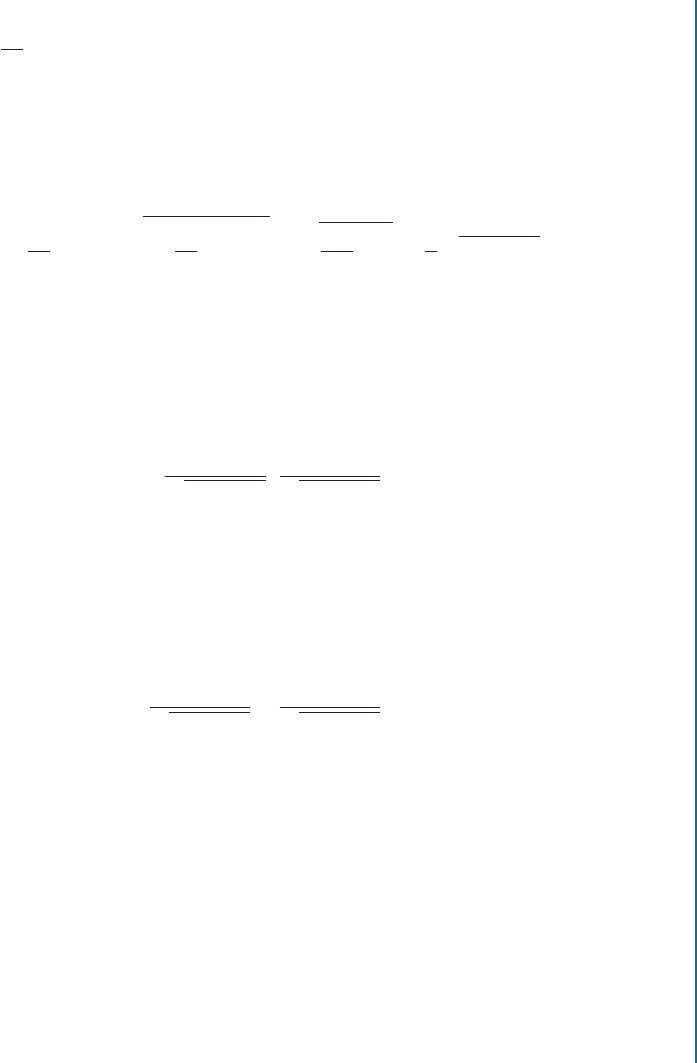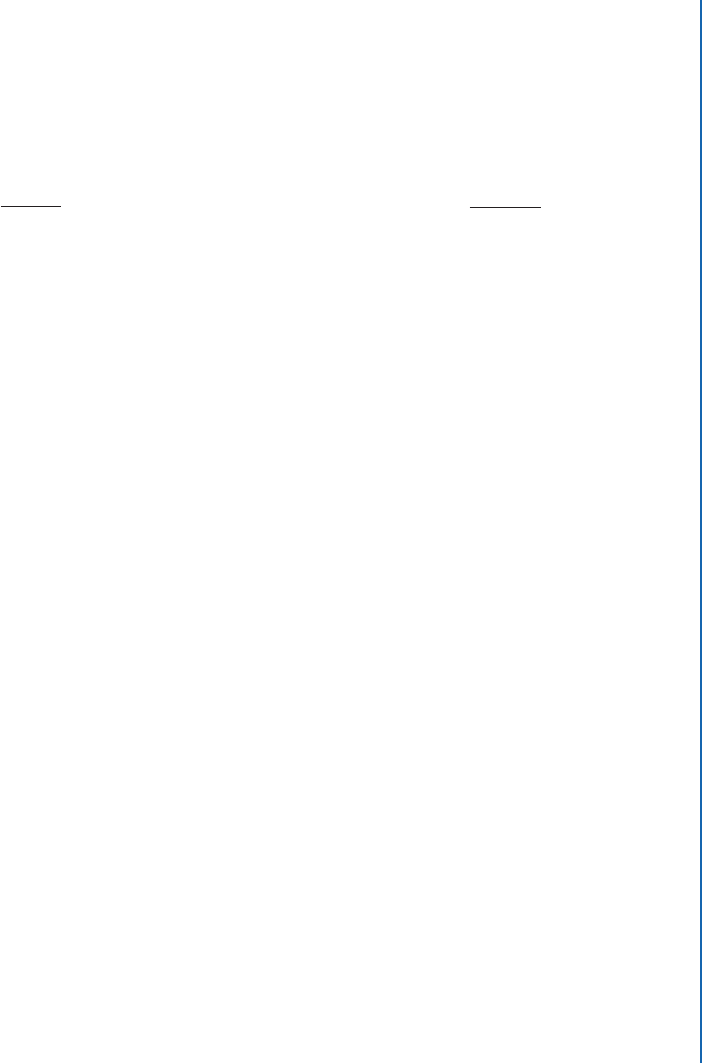
20 1. ADVANCED DERIVATIVES
In Example 1.35 we can plot the level curves because we recognize them as ellipses. In
general, that’s not going to work. If we supply a graphics system with information about the
gradient of a curve, then it can sketch level curves by following the correct directional derivative.
Knowledge Box 1.6
If z D f .x; y/ defines a surface, then the level curve at the point .a; b/ proceeds
in the direction of the unit vector Eu such that
jr
Eu
f .a; b/j D 0:
In other words, it proceeds in the direction such that the height of the graph of
f .x; y/ is not changing.
Example 1.36 Find, in general, the direction of the level curves of
f .x; y/ D x
2
C 3y
2
:
Solution:
To find the general direction of level curves, we need to solve this equation for Eu.
jr
Eu
f .a; b/j D 0
Let Eu D .a; b/:
r
x
2
C 3y
2
.a; b/ D 0
.
2x; 6y
/
.a; b/ D 0
2xa C 6yb D 0
2xa D 6yb
a D 3
y
x
b
Giving us the direction in which the level curves go.

1.2. THE GRADIENT AND DIRECTIONAL DERIVATIVES 21
If we set b D 1, then, at a given point .x; y/ in space, the level curve at that point is in
the direction
3y
x
; 1
. is encodes the direction.
To be thorough, let’s turn this into a unit vector.
ˇ
ˇ
ˇ
ˇ
3y
x
; 1
ˇ
ˇ
ˇ
ˇ
D
s
3y
x
2
C 1
2
D
r
9y
2
x
2
C 1 D
1
x
p
9y
2
C x
2
So, the direction, as a unit vector is:
3y
p
9y
2
C x
2
;
x
p
9y
2
C x
2
!
Notice that if we had chosen b D 1, we would have gotten
3y
p
9y
2
C x
2
;
x
p
9y
2
C x
2
!
which is an equally valid solution.
e level curve points in two opposite directions.
˙

22 1. ADVANCED DERIVATIVES
A natural question at this point is: what do the vectors we found in Example 1.36 look like?
Example 1.37 Using the solution to Example 1.36 plot the directions of the level curves as a
vector field.
Solution:
4.0
-4.0
-4.0 4.0
At each point, there are actually two vectors that point in the direction of the level curve. If Eu
points in the direction of the level curve, then so does Eu. e figure above sometimes shows
one and sometimes the other. e curves that these vectors are following track the vertically long
ellipses that one would expect as level curves of:
f .x; y/ D x
2
C 3y
2
˙

1.2. THE GRADIENT AND DIRECTIONAL DERIVATIVES 23
PROBLEMS
Problem 1.38 For each of the following functions, find their gradient.
1. f .x; y/ D x
2
C 4xy C 7y
2
C 2x 5y C 1
2. g.x; y/ D sin.xy/
3. h.x; y/ D
x
2
y
2
C 1
4. r.x; y/ D
x
2
C y
2
3=2
5. s.x; y/ D sin.x/ Ccos.y/
6. q.x; y/ D x
5
y Cxy
5
C x
3
y
3
C 1
7. a.x; y/ D
x
x
2
C y
2
8. b.x; y/
D
x
y
Problem 1.39 For the function
g.x; y/ D x
2
C 3xy Cy
2
;
remembering that directions should be reported as unit vectors, find:
1. e greatest rate of growth of the curve in any direction at the point .1; 1/
2. e direction of greatest growth at .1; 1/
3. e greatest rate of growth of the curve in any direction at the point .1; 2/
4. e direction of greatest growth at .1; 2/
5. e greatest rate of growth of the curve in any direction at the point .0; 3/
6. e direction of greatest growth at .0; 3/
Problem 1.40 Suppose we are trying to find level curves. Is it possible to find points where
there are more than two directions in which the surface does not grow? Either explain why this
cannot happen or give an example where it does.
Problem 1.41 For each of the following functions, sketch the gradient vector field of the func-
tion for the points .x; y/ with
x; y 2 f0; ˙1; ˙2; ˙3g:
Exclude points, if any, where the gradient does not exist. is is a problem where a spreadsheet
may be useful for performing routine computation.

24 1. ADVANCED DERIVATIVES
1. f .x; y/ D x
2
C y
2
C 1
2. g.x; y/ D sin.xy/
3. h.x; y/ D
x
x C y
4. r.x; y/ D
p
x
2
C y
2
5. s.x; y/ D sin.x/ Ccos.y/
6. q.x; y/ D x
5
y Cxy
5
C x
3
y
3
C 1
Problem 1.42 Find the directional derivative of
f .x; y/ D x
2
C y
3
in the direction of (1,1) at (0,0).
Problem 1.43 Find the directional derivative of
g.x; y/ D x
2
y
2
in the direction of .
p
3=2; 1=2/ at (2,1).
Problem 1.44 Find the directional derivative of
h.x; y/ D .y 2x/
3
in the direction of (0,-1) at (-1,1).
Problem 1.45 As in Example 1.36 find the general direction for level curves at .x; y/ for the
function
H.x; y/ D
1
x
2
C y
2
and plot the vector field for all points with whole number coordinates in the range 3 x; y
3.
Problem 1.46 As in Example 1.36 find the general direction for level curves at .x; y/ for the
function
H.x; y/ D
2
x
2
2x C y
2
2y C 2
and plot the vector field for all points with whole number coordinates in the range 5 x; y
5.
Problem 1.47 Which way will a ball placed at (1,1) on the surface given by the function in
Problem 1.42 roll?
..................Content has been hidden....................
You can't read the all page of ebook, please click here login for view all page.
